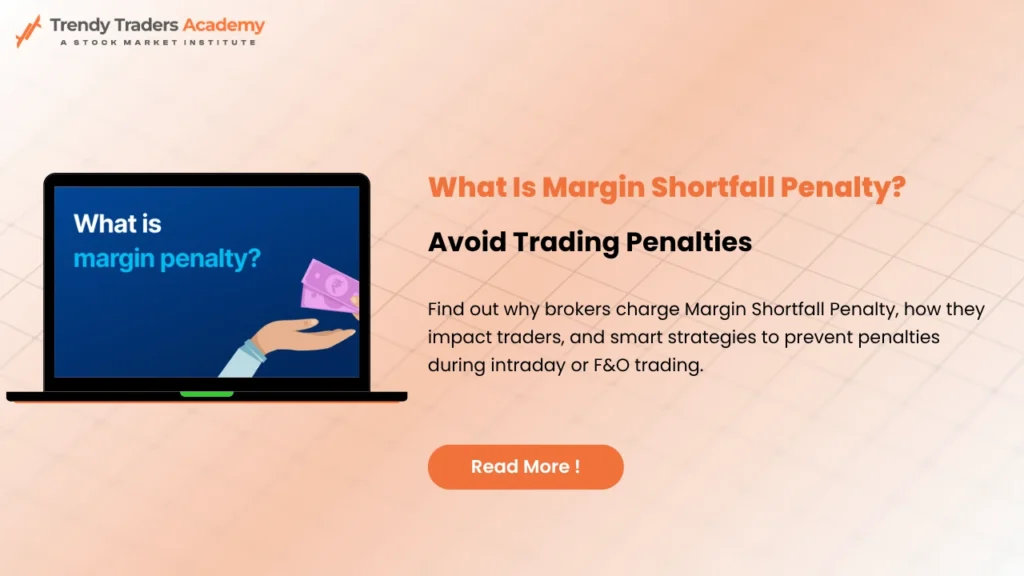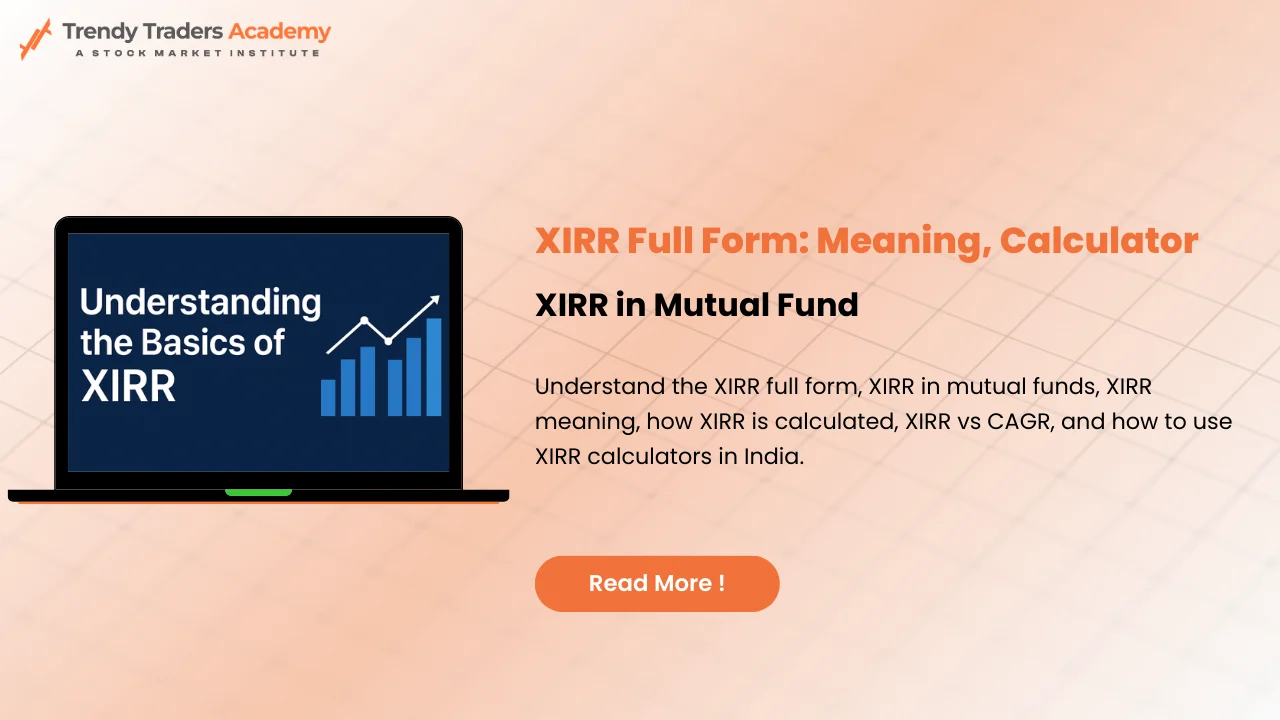
What Is Margin Shortfall Penalty? | Avoid Trading Penalties
Have you ever been surprised by a “margin shortfall penalty” in your trading account? It’s like being charged a late fee when you forget to pay your credit card bill – except this one comes from your broker. Many traders face this penalty without even realizing what caused it.
We’ll break down what is margin shortfall, why it happens, how to calculate it, and most importantly, how to avoid a margin shortfall penalty in this blog. The exact meaning, causes, and prevention methods in simple, real-world terms can be learnt from this blog.
What Is Margin Shortfall?
When the funds in your trading account are less than the required margin set by the exchange or your broker, here occurs the margin shortfall.
In simple words, if your broker asks for ₹1,00,000 margin to hold a position and you only have ₹80,000 – you have a shortfall margin of ₹20,000.
This shortfall triggers a margin shortfall penalty if not corrected within the prescribed time.
What Is Margin Shortfall Penalty?
Margin shortfall penalty is a charge imposed when you fail to maintain the required margin while holding open positions in the stock market.
According to SEBI regulations, both the trader and the broker must ensure full margin is collected upfront. If it’s not maintained, the exchange applies a shortfall margin penalty.
The penalty usually ranges from 0.5% to 1% per day on the shortfall amount, depending on the severity and frequency.
Margin Shortfall Meaning in Simple Terms
Think of the margin as a security deposit you keep with your broker before making a trade. A margin shortfall means your deposit fell short.
It’s not about losing money yet – it’s about not meeting the minimum balance requirement for your open positions.
If your balance keeps falling and isn’t topped up, you may get penalized or your position could be squared off automatically.
How Does Margin Shortfall Occur?
Margin shortfalls typically happen due to:
- Sudden price fluctuations in your positions.
- Additional exposure from new trades without adding funds.
- Delay in fund transfer from your bank.
- Incorrect margin calculation by traders.
- Broker system updates not reflecting your latest balance.
Example: If you’re holding a NIFTY futures position and the market moves sharply against you, your margin requirement might increase instantly – causing a shortfall.
Types of Margin Requirements (SPAN, Exposure, etc.)
Type | Description |
SPAN Margin | Covers potential losses based on volatility and risk. It’s the minimum margin you must maintain. |
Exposure Margin | An additional buffer over SPAN margin to manage unexpected market movements. |
- Both these combined make up your total margin requirement.
- If your funds fall below this total, a margin shortfall occurs.
SEBI Rules on Margin Shortfall Penalty
The Securities and Exchange Board of India (SEBI) has clear guidelines to prevent excessive leverage and protect investors.
According to SEBI:
- Full upfront margin must be collected before taking a position.
- Brokers must report margin collection daily.
- Shortfall penalties apply for any non-collection or under-collection.
Penalty for Margin Shortfall
If a trading member fails to maintain the required margin, their trading privileges are suspended immediately until compliance is restored.
To discourage repeated violations, penalties for margin shortfalls are imposed on a monthly basis, depending on how often such disablements occur. The charges are structured as follows:
Instances of Disablement (within a month) | Penalty Details |
1st Instance | 0.07% per day on the margin shortfall amount |
2nd to 5th Instance | 0.07% per day + ₹5,000 per instance (from 2nd to 5th) |
6th to 10th Instance | 0.07% per day + ₹20,000 (cumulative for 2nd–5th) + ₹10,000 per instance (from 6th to 10th) |
11th Instance & Beyond | 0.07% per day + ₹70,000 (cumulative for 2nd–10th) + ₹50,000 per instance (from 11th onwards). The member may also be referred to the Member Committee for further disciplinary action. |
Note: Each instance of disablement is counted for all margin-related violations during market hours in a single calendar month. The daily penal rate of 0.07% is applied on all margin shortfalls detected at any point during trading hours.
Penalty for Short / Non-Reporting of Client Margins or Short Allocation
If a trading or clearing member under-reports, fails to report, or allocates insufficient margins for clients, the following penalties apply per instance:
Extent of Short Collection (per client) | Penalty Rate |
Less than ₹1 lakh and less than 10% of required margin | 0.5% of the shortfall amount |
₹1 lakh or more or 10% or more of required margin | 1% of the shortfall amount |
Additional penalties apply for continuous or frequent shortfalls, as shown below:
- If the short or non-collection continues beyond 3 consecutive days, a 5% penalty per day is levied on the shortfall amount for each day after the 3rd day.
- If such shortfalls occur for more than 5 days in a month, a 5% daily penalty on the shortfall amount applies for every additional day beyond the 5th day.
- Any instance of non-reporting is treated as 100% short reporting for the purpose of calculating penalties.
How to Calculate Margin Shortfall Penalty
Let’s understand with a formula:
Penalty = Shortfall Amount × Penalty Rate × Number of Days
Example:
- Shortfall Amount = ₹50,000
- Penalty Rate = 0.5%
- Duration = 2 days
Penalty = ₹50,000 × 0.005 × 2 = ₹500
So, the trader will pay ₹500 as a margin shortfall penalty.
Example of Margin Shortfall Penalty Calculation
Scenario | Required Margin (₹) | Available Margin (₹) | Shortfall (₹) | Penalty Rate | Days | Total Penalty (₹) |
Case 1 | 1,00,000 | 90,000 | 10,000 | 0.5% | 1 | 50 |
Case 2 | 2,00,000 | 1,80,000 | 20,000 | 1% | 3 | 600 |
Case 3 | 1,50,000 | 1,00,000 | 50,000 | 0.5% | 2 | 500 |
Common Reasons for Margin Shortfall
Some frequent causes include:
- Leverage misuse – taking larger positions without enough funds.
- Market volatility – sudden price drops increase required margins.
- Fund transfer delays from your bank.
- Non-updated margin files by brokers or exchanges.
- Intraday to delivery conversion without adding funds.
- Always maintain an extra margin buffer (5-10%) to stay safe.
How to Avoid Margin Shortfall Penalty
You can avoid penalties with a few smart trading habits:
- Monitor margins daily through your broker’s dashboard.
- Keep surplus funds in your trading account.
- Avoid over-leveraging – don’t risk more than you can afford.
- Set alerts for margin calls or low balances.
- Understand SPAN + Exposure requirements before every trade.
Many brokers now provide real-time margin calculators – use them before placing an order.
Role of Brokers and Clearing Corporations
Both brokers and clearing corporations play a role in enforcing margin rules:
- Brokers collect margin from traders and report it to the exchange.
- Clearing Corporations (like NSE Clearing) monitor compliance.
- If brokers fail to collect the full margin, they too face penalties – which are usually passed to the trader.
So, it’s a shared responsibility between the trader and broker.
Margin Shortfall in Futures and Options Trading
In F&O trading, margin requirements are dynamic.
- Margins increase when volatility spikes.
- Overnight positions often need higher margins than intraday trades.
- If your account balance drops due to MTM losses, it triggers a margin shortfall.
Always check your available margin vs. required margin after every trade.
Intraday Trading and Margin Shortfall Risks
Intraday traders often use high leverage, which can quickly lead to shortfalls if trades go wrong.
For example, if your broker gives 5x leverage and your position moves against you by 2-3%, your available margin could vanish instantly.
That’s why intraday traders must always:
- Square off positions before the cutoff time.
- Avoid carrying leveraged trades overnight.
Difference Between Margin Shortfall and Negative Balance
Aspect | Margin Shortfall | Negative Balance |
Definition | When available margin is less than required margin | When total account balance becomes negative |
Penalty | Charged by exchange | Interest charged by broker |
Example | Required ₹1L, have ₹80k | Balance -₹5,000 due to loss |
A margin shortfall can lead to a negative balance if not resolved quickly.
Conclusion
A margin shortage penalty is not a fine – it is an indicator that your trading risk is out of proportion. With the help of appropriate funds, position monitors and margin calculators you will be able to evade unnecessary penalties and trade without any hesitation.
Note: Discipline is what will protect you in trading penalties and losses. Keep in the know, keep alert and trade smart.
FAQ'S
What is a margin shortfall penalty?
A margin shortfall penalty is a charge imposed when a trader’s available margin is less than the required margin set by the exchange.
How is margin shortfall calculated?
It’s the difference between the required margin and the available margin in your trading account.
What is the SEBI rule for margin shortfall penalty?
SEBI mandates a penalty of 0.5% to 1% per day on the shortfall amount, depending on the duration and frequency of violation.
Does margin shortfall apply to intraday traders?
Yes. If you don’t close your intraday positions on time or margins fall short, penalties may apply.
What happens if I don’t pay the margin shortfall penalty?
Your broker may block trading access or square off your open positions.
Is margin shortfall penalty applicable in delivery trades?
It can apply if you use margin funding or leverage and fail to meet margin requirements.
What is shortfall margin meaning in trading?
It means your trading account has less capital than the minimum margin required to maintain your positions.









